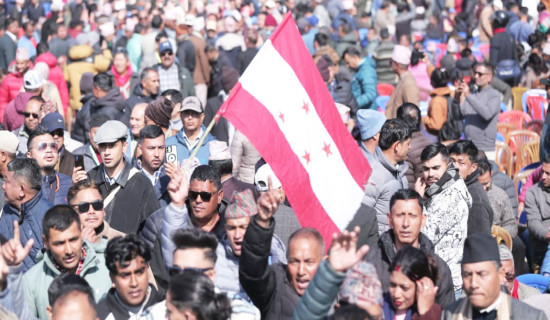- Monday, 12 January 2026
Long-term solution imperative to address squatters’ problem
BY SUSHMA MAHARJAN, Kathmandu, Dec. 4: The issue of landless squatters is not new to Kathmandu residents. It comes up and goes off the media. It has made headlines once again after the Kathmandu Metropolitan City (KMC) dozer arrived at the squatters’ settlement on the banks of the Bagmati River in Thapathali area on Monday to vacate the settlement.
According to the Nepal Gazette, landless squatters are those who do not have any valid land certificate and are unable to manage real estate in the name of any family members. In Kathmandu, the landless squatters are mostly found in Shankhamul Squatter Settlement, Paurakhi Basti Squatter Settlement, Ramhiti Improved Squatter Settlement and Slum area in Dhaukhel, Kalimati.
Of late, KMC had taken steps to remove the squatters form Paurakhi Basti Squatter Settlement. A clash took place between the squatters and KMC city police unit where 18 city police were injured including chief of city police Raju Nath Pandey and one other critically. The squatters residing along the banks of Bagmati River even staged a demonstration at Thapathali and outside the office of the KMC demanding proper management of the squatters and resignation of KMC Mayor Balendra Shah.
Earlier, the Integrated Bagmati Civilization Development Committee, which has the authority to remove the houses built on the banks of the river, construction materials and vehicles, had issued a public notice earlier. According to the notification, the settlement structures had to be removed by November 20. The KMC had arrived at the settlement after the structures were not removed by the deadline.
But the removal of the squatters has been halted once again after the National Land Commission (NLC) released a notice on Friday with a statement that the works are underway to collect and verify details of landless Dalits, landless squatters and those residing unsystematically. It has asked KMC and all local bodies not to remove the squatters from the settlement and make them homeless until detailed documents are prepared.
Here, it seems Nepal Government has not been able to address the issue of the landless squatters and come up with any permanent solution. Shiva Prakash Paudel, writer and analyst, said that the political parties have not taken serious steps to resolve the issue and kept it as it is.
Instead of coming up with the sustainable solution to the problem, political leaders have instead been using the problem for their gains and giving consolations to the squatters. The political parties have been assuring and reassuring the squatters that they would solve their problems if they formed the government, but it has never happened so, he added.
Meanwhile, the squatters from the area seem determined not to vacate the place where they have been living unless acceptable alternative arrangements are made for them. They have demanded for a replacement location inside the Kathmandu valley.
Hukum Bahadur Lama, a squatter, said that they should not be deprived of the basic human rights and should be given alternative to the settlement. “We don’t want to start our livelihood at remote areas. We need to be relocated within the Valley,” he added.
But the question has arose weather the people residing in the squatter settlement are real squatters or just residing there for the namesake or/and acting under the influence of political parties? It is estimated that only 15 to 20 per cent of the total landless squatters are the real ones.
Sher Bahadur Shahi claims himself to be a squatter despite having a two-storey house in Baneshwor. There are many like Shahi residing in the settlement.
Even on social media, many of the demonstrators were found wearing gold jewelry and carrying an iPhone.
Krishna Maya Magar, a squatter, said that earlier, some huts were bought and sold in the settlement and newcomers started to reside there. Even some Indians are living in the settlement after buying space from previous Nepali owners, she said.
Therefore, we can say that there are many kinds of squatters in the settlement. Some are nominal occupiers, some are squatter-landlords who rent out accommodation, some have houses outside and calling themselves as squatters and some squatter-tenants who rent the property.
However, the landless squatters are not a problem in themselves. Rather, it is their problems that render people a landless squatter.
Thus, the government should come up with new policies to recognise the existing genuine slums and squatter settlements and prevent the formation of such areas in the future, to make provision for easy finance options and affordable housing units, as well as to establish special funds for upgrading and relocating squatters. At the local level, different forms of land tenures should be granted to squatters after classifying them based on their characteristics.




-square-thumb.jpg)









-original-thumb.jpg)

